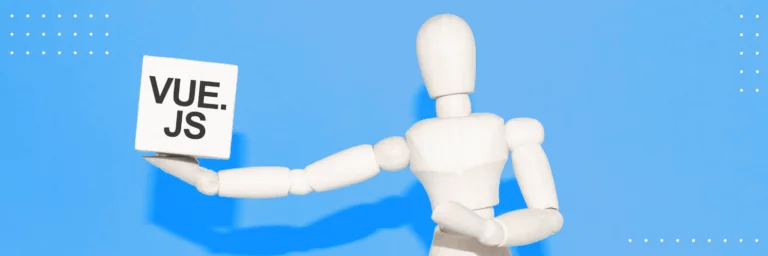Crafting Successful Educational Apps in 2024: A Comprehensive Guide to Educational App Development
Key takeaways
- Educational apps cover a wide range of e-learning solutions that facilitate convenient learning and streamlined digital educational experiences. To provide your users with the best possible CX, discover modern trends to follow, from using VR technologies to empowering your product with AI.
- Explore different types of educational apps with us for a broader understanding of the nature of such solutions.
- Get information about key features of learning apps so you can add them during education app development to make your solution convenient for your users.
- Study a step-by-step guide to developing apps for learning and get useful tips that will come in handy during the education app development process.
- Your educational app should be highly performant, provide seamless CX, and offer users robust functionality. Check our tech recommendations that will help you ensure a winning education app development.
- Discover information important for every business owner on how much it costs to develop educational applications. We have prepared a detailed cost estimation for you.
- How should you monetize your training app in this competitive market? Learn the most profitable monetization strategies to bring in your desired income.
Smartphones today have become full-fledged guides to the world of knowledge. And we are not talking about the Internet and access to an unlimited supply of facts and dates, but about educational apps. The market of e-learning apps is growing with a striking speed, becoming one of the top industries with a number of products adapted to mobile. For example, the educational app sector generated $7 billion in revenue in 2022, marking a 7.2% increase from 2021. And language learning app Duolingo emerged as the most popular learning and education app globally, amassing 98 million downloads.
If you want to break into this fast-growing field with your idea, then our detailed guide will be of great help to you. In this article, you will learn about the main trends in educational apps, their main types, and features that every self-respecting product needs. In the second part of the post, we will look at how to make an educational app, determine its potential value, and consider the monetization method. In the end, you will learn some valuable tips that will help you throughout the education app development.
Unveiling the world of educational app development
Before creating your application, studying popular trends will be the key step to start with. Adopting the most relevant ones to your type of product will help make your app more interesting and relevant for the end-user.
Virtual Reality (VR)
The opportunities provided by VR allow for interacting remotely in three-dimensional space and developing a wide variety of skills, from drawing to rhetoric. The advantage of VR will find use in any educational app: both in Quiver children’s coloring and InMind, which makes it possible to experience the journey into the brains of a mental disorder.
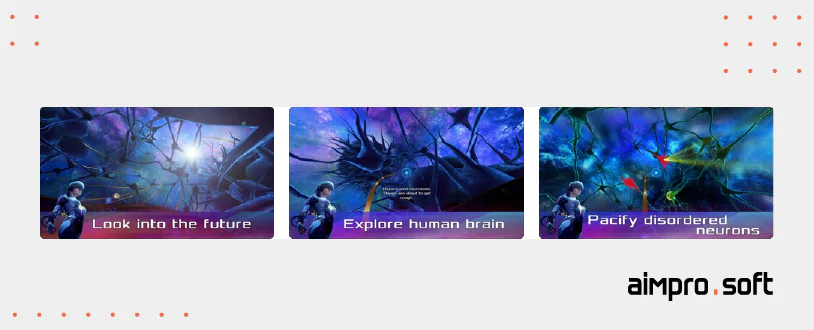
Interface of InMind VR for iOS
These opportunities create a complete immersion in the learning process and disperse its boredom. Thanks to the use of VR technologies, you will attract great interest not only from the target audience of educational apps lovers but also from tech-savvy fans and gamers. The flip side of the coin is development difficulties and the high cost of VR applications.
Augmented Reality (AR)
AR adds to educational apps amazing content visualization capabilities, enhancing the real-life experience of using the product. Just like its technological fellow VR, AR finds fertile ground for integration in all types of educational apps: Star Walk for exploring celestial objects or a realistic product for exploring the human body Anatomy 4D.
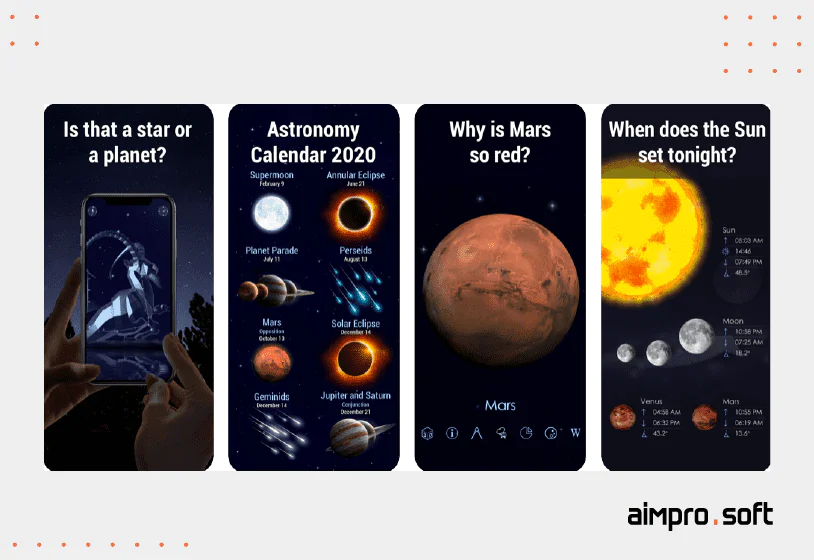
Screenshots of Star Walk 2 AR for iOS
AR is a fairly new and complex technology, so you will need highly qualified specialists for its integration. However, rewards in the form of increased public interest and advanced features are worth it.
Gamification
This trend directly follows VR and AR, but it distinguishes favorably with the fact that you can achieve gamification without the introduction of such expensive technologies. One of the most common issues of educational apps is the low level of interest and motivation for users. Gamification avoids this by adding excitement to non-game elements of the application. It can be both competitive and entertaining.
Bright representatives of educational apps with gamification are:
- Duolingo — each language lesson has a game element (hearts of life, scores, a timer);
- Yousician — the user selects the instrument and song, and the program gives instant feedback evaluating the performance;
- Sololearn — the user learns the code and, at the same time, gains XP (Experience points), competes with other people in coding, and tracks his/her progress on the global leaderboard.
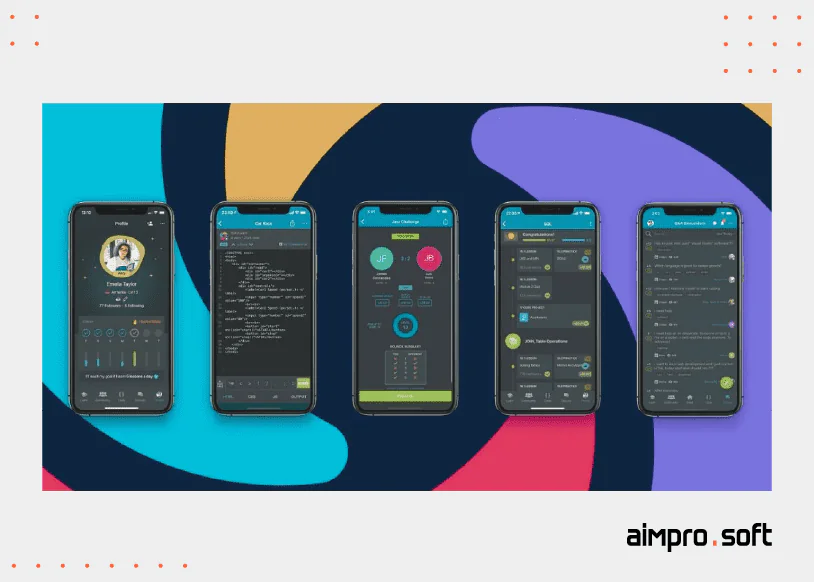
Screenshots of SoloLearn for iOS
Gamification give you the opportunity to maintain a high level of interest in your educational app at an affordable cost.
Artificial Intelligence
The development of AI in recent years has allowed the use of Advanced Intelligent Virtual Assistants in many areas, including educational app development. Here, the IVA takes over the briefing, management, and overall improvement of the learning process in the application.
Boost of AI has created smart algorithms that evaluate the user’s abilities and rebuild the style, complexity, and content for them. In other words, introducing AI into your educational app will help you achieve adaptive learning. As a result, both your users and you will benefit from it because the quality of the product will go to a new level. Also, with AI implementation, you will save on scientific experts because machine learning algorithms will independently determine the necessary complexity of the material for each particular case.
The significance of understanding trends is undeniable, but it is even more important to consider all the aspects of the application type you are developing, as this is a matter of strategic importance.
Navigating types of educational apps
Your target audience and promotion methods will depend on the selected type of educational app. Let’s look at the main types in the market and identify their strengths and weaknesses.
Educational apps for kids
Children are drawn to modern devices, and parents who care about the development of their children from an early age are trying to reap benefits from their hobby. These can be the most diverse applications — for learning reading, writing, science, or developing talents. Any idea can shoot; you just need to adhere to the principles of visual appeal and casualness — children should like the appearance of the product and not get scared away by complexity.
Best representatives: ABCmouse, Epic!, Quick Math Jr.
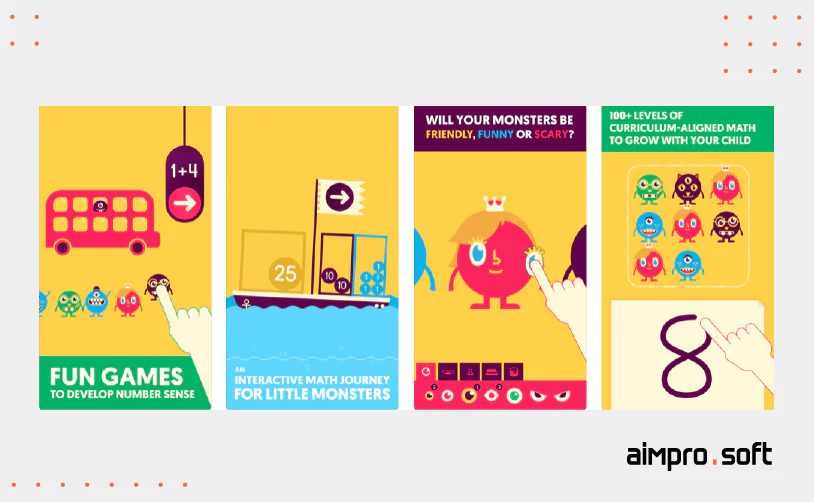
Screenshots of Quick Math Jr. for iOS
Classroom apps
Applications for students and teachers can be of two types. The first of them is used during lessons, serves teachers as tutorial material, and helps organize the learning process and instruction. The second type is a cloud-based application and is used for remote learning. It centralizes all teaching materials in one place and has options for communication between teacher and parent, control of behavior, and knowledge.
Best representatives: Kahoot, Google Classroom, Classtree
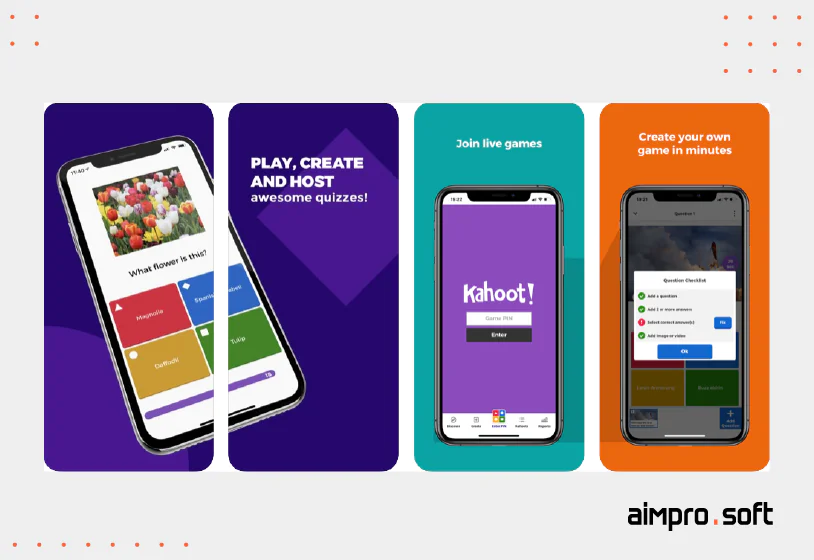
Interface of Kahoot! for iOS
Test preparation apps
Targeted primarily at students and pupils, this type of educational apps offers up-to-date curriculum training tests for admission, quizzes, or exams. Despite the limited audience of students, test preparation apps are always relevant: every year, millions of students go to universities and look for all possible tools to help them. Test prep apps are some of the best means for this. Remember that you will have to constantly keep abreast of educational programs and update the content to their current state.
Best representatives: Gradeup, EduRev, PocketAptitude
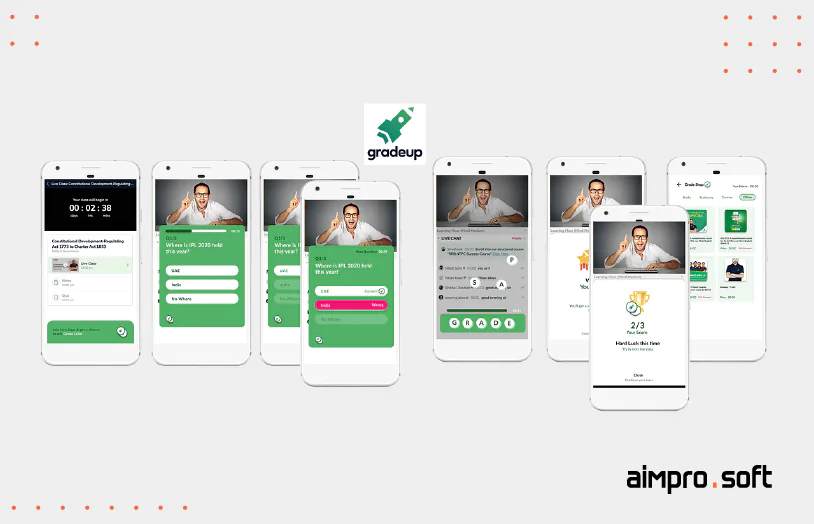
Gradeup interface
Online courses
This type is aimed at adults who are looking for new knowledge, but they do not have the time or opportunity to attend courses. In online course apps, training programs are given in an interactive form with abundant multimedia material. One of the main considerations for you is the question of the original content: whether it will be authorship or materials from famous universities.
Best representatives: Linkedin Learning, Coursera, iTunesU
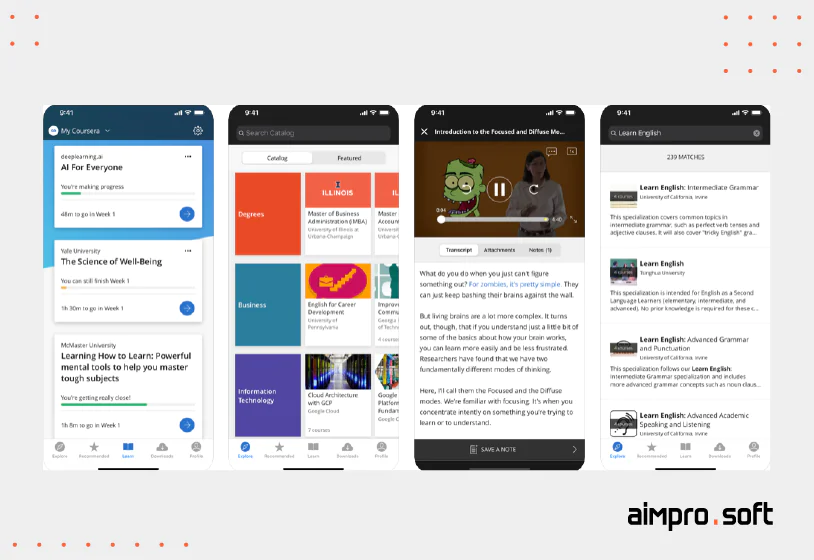
Screenshots of Coursera for iOS
Language learning apps
Learning a language is arguably the most popular type of educational app use. Having become popular in recent years, it has gained new facets in mobile presentation.
All language learning apps are similar in delivering learning material while playing. If you develop an educational app for language learning, take into account the level of users’ knowledge, structure the material from simple to complex, and enter a variety of modes. In order to stand out from the crowd of competitors, we recommend that you inventively apply technologies like progress tracking and in-app chat, as well as develop your own unique methodology.
Best representatives: DuoLingo, Memrise, LinguaLift
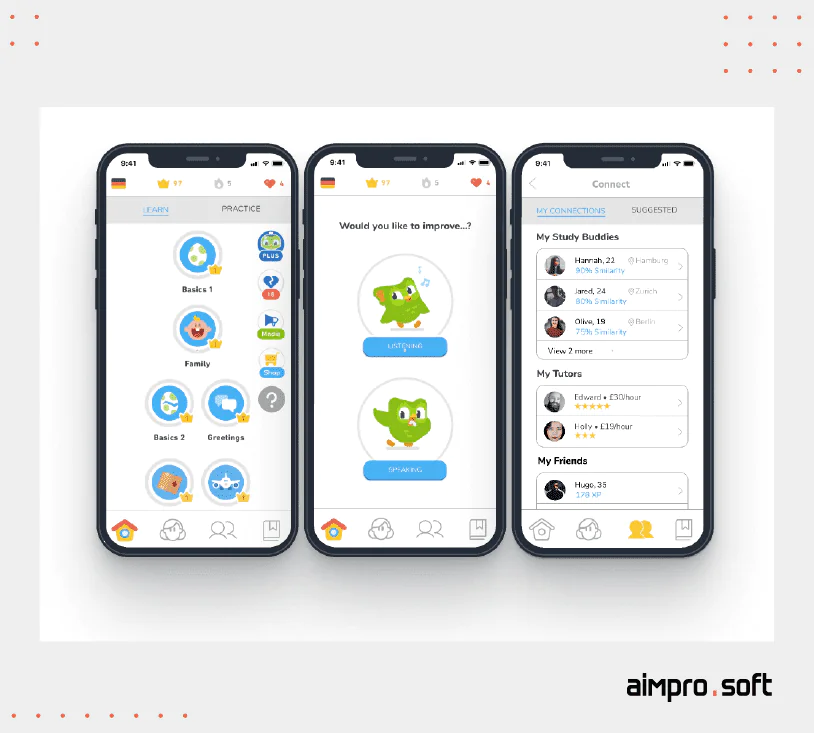
Duolingo interface
Brain training apps
Being the closest type to the game applications from the list, it is essentially a set of mini-games for logic, memory, and attention. The learning element is enhanced by detailed and colorful infographics about the abilities of the users and their development progress. They are lightweight and suitable for any audience, but you must be ready to face the hordes of competitors.
Best representatives: MentalUP, Lumosity, Elevate
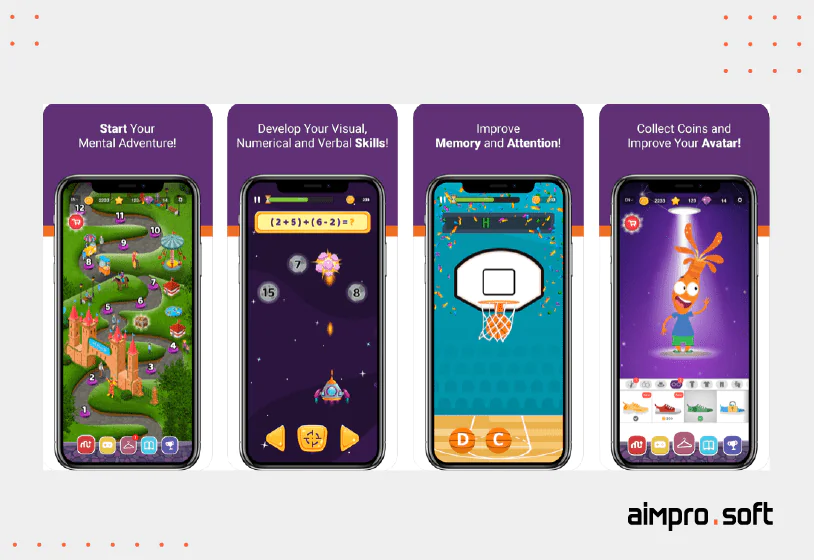
Screenshots of MentalUP for iOS
Multipurpose learning apps
Multi-purpose learning apps are comprehensive digital environments designed to meet various learning needs. Multi-purpose learning platforms cover a wide range of topics, skills, and educational levels to reach a wide range of learners. They often provide content from maths and science to humanities and language arts. Likewise, users can often customize their learning experience based on their preferences, pace of learning, and individual needs. Personalization features can include adaptive learning paths, progress tracking, and unique content recommendations.
Best representatives: Skillshare, Khan Academy, Quizlet
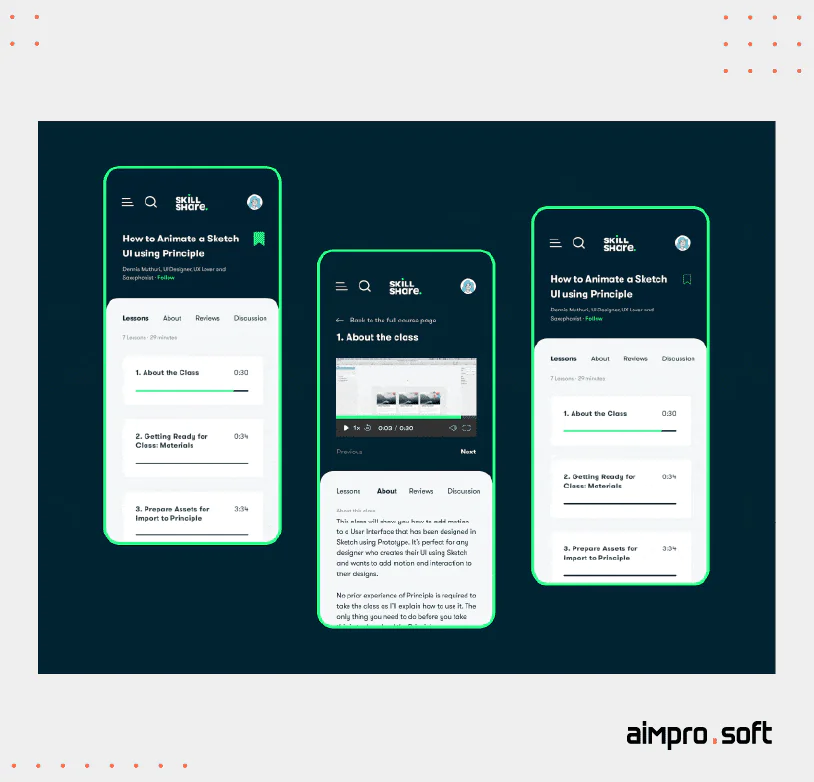
Skillshare interface
Reading and writing apps
Reading and writing apps are digital tools designed to enhance literacy skills by providing interactive and engaging experiences in reading comprehension and written expression. These apps cater to various age groups and skill levels, offering features that facilitate language development, grammar proficiency, and creative writing abilities.
Best representatives: Ling App, Writing Challenge, Audible
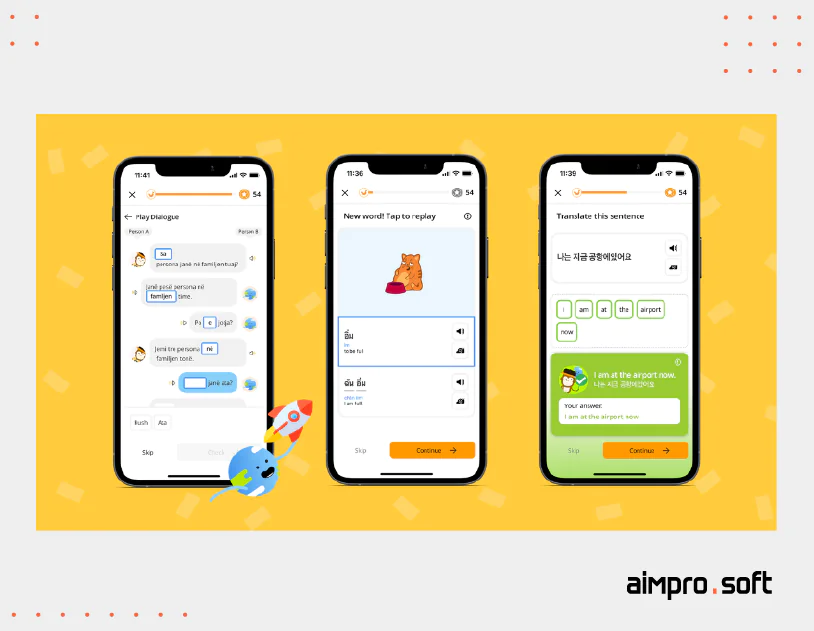
Ling App interface
Now that you’ve become familiar with the types and trends of educational apps, it’s worthwhile to dwell on the most necessary features for your mobile educational product.
Essential features for your educational app
Speaking of educational apps features, we cannot fail to mention the fact they have many specific features relevant only to this type of application. Here, we will consider exactly such features without which the education app development would not be its true self.
| Learning material | The main element of the educational app development can be divided into interactive exercises and audio/video content with rules, explanations, and tasks. It is uploaded on the admin site and then appears in the mobile app. The material must have a reputable source or author who has created it. |
| Lesson categorization | Learning material will benefit from thoughtful categorization. You can catalog it depending on the topic, complexity, or the level of knowledge of the user. |
| System of scheduling | Healthy learning requires proper organization. With it, the user will be able to approach the learning process in your app systematically. The division into logical blocks will allow assimilation of the material better. |
| Statistics of learning progress | Visually observing the learning process gives pleasant emotions and motivates stronger. A user should be enabled to enter the infographic after passing the lesson/task, where the progress or regression is shown in percentage terms. Awards celebration of the most successful results can be another pleasant point for the learner. |
| Success assessment | Education app’s feature that is most difficult to implement. Success assessment is responsible for analyzing the user’s level of knowledge and controlling its growth or regression. It can be approached from several sides: go deeper into the introduction of Machine Learning, create a decision-making system, or settle for simple algorithms. |
So, we’ve looked at an essential set of features that should be in almost every e-learning application. Now, let’s look at the main steps of creating such an application and at what stages these features are implemented.
Building your educational app: A step-by-step guide
Educational app development is not too drastically different from creating other applications. Let’s follow a step-by-step guide that ensures you will get your app in time according to high standards of education app developmen.t
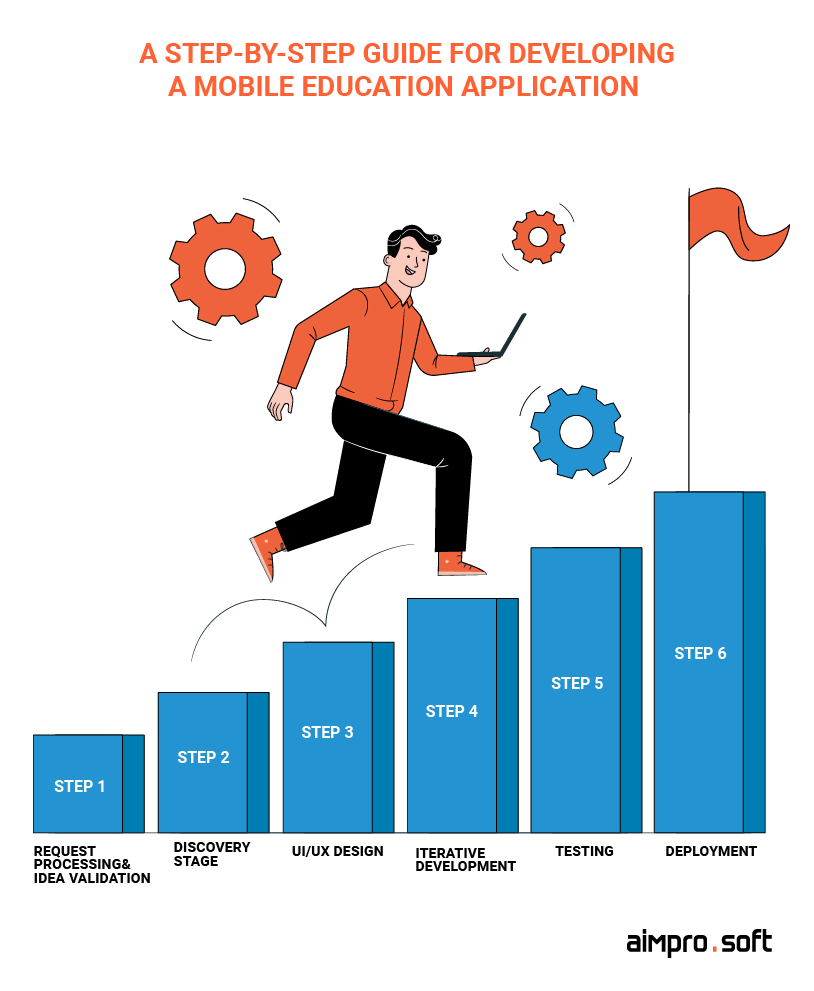
A step-by-step guide to developing an E-learning app
Step 1: Ideation
In this initial phase, the concept of the educational application is formulated and discussed with the vendor. A vendor starts the work on the product, checks the viability of the idea, and, based on the gathered initial requirements, designs a statement of work (SoW) that specifies the technical documentation and key features. Mock-ups are developed to visually represent the application interface to facilitate a common understanding among stakeholders. A comprehensive SoW is critical at this stage to avoid complications during subsequent education app development.
Step 2: Research
Once the request is analyzed, the requirements should be documented in the form of SRS and delivered to the development team. Requirements are allocated to education mobile app development phases, and the allotted hours are summarised for transparency. Active communication between the development team and the client is encouraged to ensure a deep understanding of the project.
Likewise, the discovery phase is often conducted during the research step, providing an in-depth look at the requirements and technical aspects. This proactive measure identifies problems and opportunities early on, reducing the likelihood of obstacles during education app development. Business analysts work closely with clients during the discovery phase to refine the project’s scope and provide accurate estimates.
Step 3: Design
With a clear understanding of the project scope, timeframes, and milestones, the software architect defines the app’s architecture and technology stack. A database solution is chosen, considering factors like performance. Native SQLite or third-party Realm may be selected. The design phase sets the groundwork for education app development, emphasizing the importance of a robust technological foundation.
Step 4: Development
The mobile team takes center stage, creating the app’s core, integrating the database and user interface, and developing general functionality. Simultaneously, the backend team may work on backend education app development to ensure a seamless and cohesive app experience. Content integration, including educational materials such as tests, is addressed based on past project experiences.
Step 5: Testing
As development progresses, rigorous testing is conducted, including unit, integration, and UI tests. These tests aim to identify and rectify potential issues, ensuring the app’s functionality aligns with expectations. Testing is a critical step in delivering reliable and error-free educational software.
Step 6: Deployment
The final phase involves deploying the app. After successful unit testing, the app undergoes QA testing, initiating the bug-fixing stage. Stakeholders review the app, providing feedback for developers to make necessary corrections. Iterative adjustments are made until the app aligns with all specified requirements, ensuring a successful deployment and a seamless learning experience for users.
Development tips and tricks
With an understanding of education app development flow, let’s dwell on the technical specifics of the application creation. A big advantage of developing an educational app over other types is that they have no dependency on device hardware. If geolocation or video chat apps need to set up a GPS navigator and a camera with a microphone, then educational one can completely do without interacting with the internal device, which saves time for development.
Do you also want to know how to develop location-based applications? Read our article on the topic.
Native development implies a complete difference between iOS and Android platforms because the implementation takes place on different infrastructures. It will overlap only when the code is placed in ReactiveX with libraries for both iOS (RxSwift) and Android (RxJava).
We have presented the tech stack of each platform separately so that it shows what technologies you need to apply and which specialists to look for.
If you want to create an educational app for Android, you should use the following technologies:
| Native platform | Tech stack | Android |
|---|---|---|
| Programming languages | Java Kotlin | |
| Toolkits | Android Studio | |
| SDK | Android SDK | |
| Video chat | WebRTC |
As long as you aim to make an educational app for the iPhone or iPad, take a look at these necessary technologies:
| Native platform | Tech stack | IOS |
|---|---|---|
| Programming languages | Swift | |
| Toolkits | Apple Code | |
| SDK | IOS SDK | |
| Video chat | WebRTC |
Differences in iOS and Android education application development are constrained directly by the platform’s limitations:
When you want to create educational Android apps, remember about the primary restriction of data synchronization — from version 8, no more than 10 seconds are allocated for background work calculations. Users with older versions will just face a crash when launching the app on their devices. Dealing with this problem is quite real: the simplest solution is using other APIs instead of Android services. If you can not drop services from your app (for example, they are necessary for GPS tracking), it is better to settle them as foreground services. Thus, the system will not remove your application, and you prevent it from crashing.
Another popular issue is ergonomic restrictions. One of the problems that you encounter when developing the Android educational app is the battery optimizer. With each new version of the operating system, Google is introducing more and more measures to save battery. Thus, on some devices, the optimizer can cancel the user’s reminders and alarms, as it is considered a lot of planned work that reduces battery power. This can threaten to reset all scheduling user activities, which will lead to disappointment with the product and frustration of user experience. To overcome it, switch the battery optimizer off.
If you build an educational app for iOS, you’ll often encounter push notification restrictions: when the application is closed, you can not affect the display of the push message. Moreover, the App Store rejects applications if the usage of push notifications in them is obligatory. In other words, the application should work without them.
There are the main restrictions in developing iOS and Android educational apps you should take into account. Now, let’s touch on the most common challenges so that you will know how to create an educational app comprehensively.
Want to learn more about app differences between native and hybrid app development? Read our blog post to learn the ins and outs of it.
Pro tips for a successful educational app development
By delving into the intricacies of the educational app development process, you can see that creating a functional and engaging app is just the beginning. While understanding the nuances of education app development is essential, true success lies in increasing the profitability and impact of your educational mobile app development. Let’s take a look at a few useful tips to help lead your educational product to success:
1 “Success assessment,” including analysis of the level of knowledge for optimal performance, is the feature that is most difficult to implement in educational apps since it should be fulfilled on a more powerful backend. In a properly organized process, the mobile team is responsible for the request, reads, and displays of such data from the server.
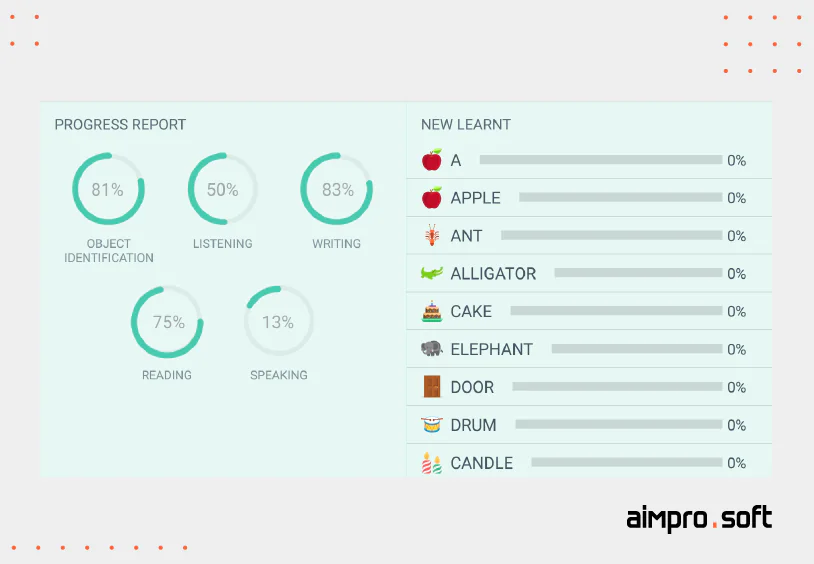
Track of the progress in Hello English Kids: Learn English
2 The easiest way to create features for assessing success is to write an algorithm that will analyze the level of knowledge of the user according to your criteria. Suppose you indicate that when scoring less than 30 points in the test, the user will be in the initial group.
Then, if he/she scores more points in subsequent tests, the program will automatically credit their growth and allocate them to the higher performance groups, as the initial results will be exceeded.
If you want to complicate the calculation for determining knowledge and introduce machine learning and complex AI, get ready to spend significantly more time on the implementation of features.
3 Despite the abundance of gamification, we do not recommend spending too much on graphics and animation. Educational interactive mini-games are simple enough for implementation and should be more understandable than aesthetically beautiful. Therefore, instead of UI, focus more on quality UX. When you aim to make an educational app, you have to understand that such a product is not the same as making a game because it is, first and foremost, a tool for learning, and it should be extremely clear so that the user does not learn methods of working with it.
Among the technical side of things, we can suggest the following tips:
- Java is recommended for backend implementation;
- we advise to use SOA (service-oriented architecture);
- it is better to write frontend on any JS MVC framework;
- store video in the cloud (Amazon S3 or any other storage provider) to save physical memory.
Calculating the costs of educational app development
Determination of your educational app potential cost is simple math: start by planning a list of desired features, add the number of developers required to implement them, and in total, you will get the hours necessary for work. For the educational app MVP, you will need the admin site for content addition and the following list of features:
- user profile;
- push notifications;
- payment system;
- in-app purchases;
- search system;
- content addition;
- lesson categorization;
- statistics of learning progress;
- success assessment.
To implement this set of features, you will need the following specialists:
- 1 Project Manager;
- 1 Tech Lead;
- 1-2 iOS developers;
- 1-2 Android developers;
- 1 Backend developer;
- 1 UI/UX engineer;
- 1 QA engineer.
Please note that for a full-feature product, the number of developers will expand, and you will need to add additional features, such as:
- social network integration;
- system of scheduling;
- statistics of learning progress;
- progress tracking;
- videos;
- chat;
- files attachment to the course.
In the case of the educational app, Business Analysis and Technical Specification stages will take 50—60 and 20—30 hours, respectively. This is the minimum time to draw up a business strategy, plan a set of features, and first drafts of UX. For this type of application, UI/UX design is more complex and important than usual, which finds expression in 60+ hours for MVP.
Most of the work will belong to the mobile department, with 400+ hours for both iOS and Android MVP. Not only will the server be located on the backend, but also more demanding functions will be performed, such as a “success assessment,” so be ready to spend 300+ hours on it. QA testing traditionally takes 20% of the total education app development time.
| Stages | MVP hours ~950—1250 | Full feature hours ~1700—2150 |
|---|---|---|
| Business analysis + UX | 50—60 | 60—80 |
| Technical Specification | 20—30 | 40—50 |
| UI/UX | 60—80 for each platform | 90—120 for each platform |
| iOS/Android development | 200—250 for each platform | 400—450 for each platform |
| Backend | 300—400 | 500—700 |
| QA | 30—50 for each platform | 60—90 for each platform |
Based on the above hours, you can assess the potential value of the educational app development:
| Country | Average hourly rate | MVP ~950—1250 | Full feature set ~1700—2150 hours |
|---|---|---|---|
| USA | $95 | $90 250—118 750 | $161 500—204 250 |
| Western Europe (Germany) | $75 | $71 250—93 750 | $127 500—162 250 |
| UK | $85 | $80 750—106 250 | $144 500—182 750 |
| Eastern Europe (Ukraine) | $45 | $42 750—56 2500 | $76 500—96 750 |
Do you want to know about the current cost of mobile app development and discover the future prices in 2024? Read our guide on this topic.
Monetizing your educational app: strategies that work
During the existence of the app markets, many monetization methods were born, some of which suited one, but were not successful with other types of products. The secret to the success of the monetization system is that it must harmonize with the app’s concept and its core mechanics. Your monetization strategy depends on many factors: business idea, audience, and market size. Let’s look closer at the current-day most popular earning methods:
1. Pay per download
With this type of monetization, the user pays once for the app and access all its functions. Typically, paid applications don’t even show ads — otherwise, your app page will be filled up with angry comments and low ratings. If you choose the pay-per-download distribution, then consider introducing a two-week or one-month free trial — no one likes to buy a pig in a poke, and the user will be able to familiarize himself with this option and love the app, having bought it with willingness after the trial expires.
2. Subscription
In this case, the user receives a free-running application, but a number of functions and features are paid for. It is better to start by creating two profiles: free and premium. Premium users who have purchased a subscription will be able to use all the features or receive additional functionality. Owners of free versions can only use the product with a number of restrictions. In this scenario, no one will force purchasing.
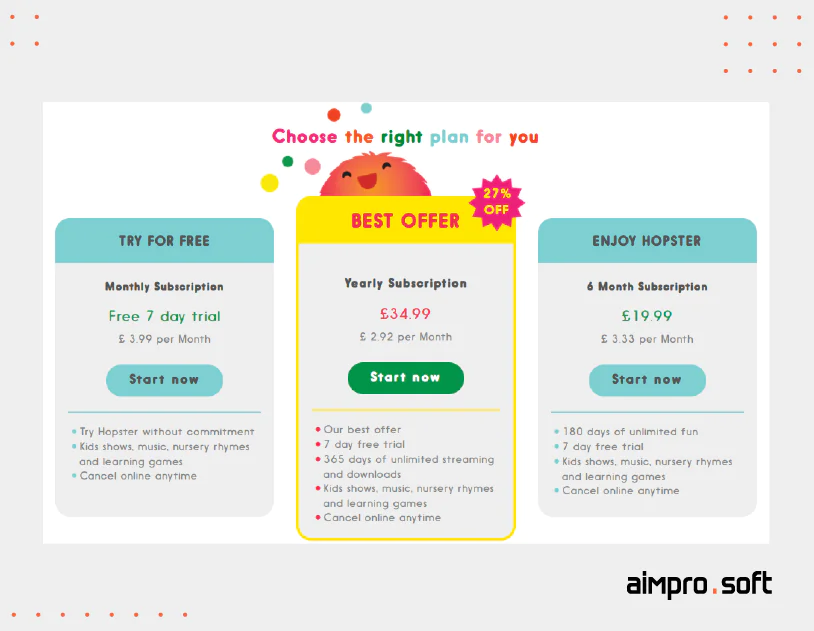
Subscription plans in the Hopster app. Source: SavvyDad
3. IAP (In-App Purchases)
The most common monetization method at the moment is in-app purchases. In the case of educational apps, the user can:
- unlock features (translator, voice pronunciation);
- open content (new mode, lessons);
- cosmetic features (menu color, avatars, stickers).
When implementing IAP, keep in mind that the App Store has introduced many restrictions, such as prohibiting the purchase of physical goods and services or the sale of content for rent.
4. Advertising
Advertising has long become an integral part of earning in applications. It is stable and is suitable for any educational product. The ads can be presented in the following form:
- banner (a pop-up window that appears on the periphery of the screen. It should be clickable with an option of closing);
- video (short video clip that can be closed after 10-20 seconds of playback. Should provide rewards for those users who watched it till the end);
- playable (a short, interactive flash game, typically a minute-long);
- full-screen (big pop-up windows, blocking the screen. Can be closed only after some time);
- notification (push notifications or SMS about favorable in-app offers).
The advertising option can be easily configured in application stores, but you need to be careful about its contents, especially if you have an app for kids. It is worth noting that, quite often, developers introduce a paid option to disable ads in the app.
Conclusion
Knowledge is power, and we can add to that well-known aphorism that it is also money. Moreover, it is easier than ever to make money on such a noble thing. For educational app development, you only need a business plan, an experienced vendor, and seed capital. With the first two, we at Aimprosoft can help: just contact us to switch from words to practice.
FAQ
What are the most efficient ways to generate revenue from an educational app?
There are several proven approaches to generate higher revenue from your app. The first efficient monetization method is a pay-per-download. To ensure that this strategy will work for you, provide your users with a short-term free trial period so that they can get familiar with the product and figure out whether it’s worth purchasing a further subscription or not.
Another option is to opt for a freemium method where you provide your users with a free app with certain premium functionality that is locked. This approach is one of the most efficient since you can develop your learning programs so that users will be interested in purchasing premium material and not forced.
One of the most common monetization methods is IAP (in-app purchases), which allows you to attract a higher number of potential users and, by offering certain paid content, keep them interested in your product. Finally, the most widespread way of earning in educational applications is in-app advertising, which is highly popular among users since they can use an app for free.
How long will it take to create an educational app?
The approximate time necessary to develop such an application depends on several factors: the desired functionality, complexity of particular features implementation, creation of an MVP version or a full-fledged product, and deadline. It will also vary if you choose to develop your product for iOS and Android simultaneously instead of selecting one of them. For example, if you decide to develop an MVP version of your educational app for both platforms, it will take you 950—1,250 hours to implement it. This estimation is based on the time required to perform Business Analysis, requirements gathering, UI/UX design, the actual functionality development for both platforms, backend implementation, and testing.
In turn, if you aim to develop a full-fledged educational app for iOS and Android, the time required to deliver the product will be approximately 1,700—2,150 hours, including the completion of all stages mentioned above.
What are the most popular trends to follow to create a competitive learning application?
There are several booming market trends that you should follow when developing an educational app to attract users and keep up with the competitors. First and foremost, consider the integration of gamification, which is regarded as one of the best ways to improve user motivation to learn and engage with your app. Secondly, prevailing video content (video lectures, rules explanation, etc.) is another popular trend to follow. Finally, the usage of such technologies as AI and AR can guarantee higher interest in your product, a better learning experience for your potential users, and as a result, increased ROI.


